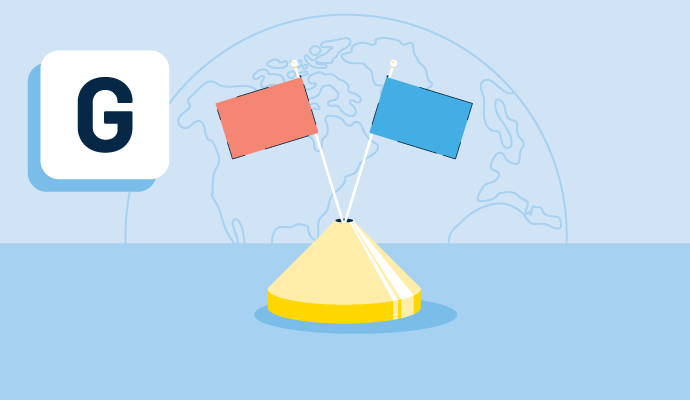What is GATT?
The General Agreement on Tariffs and Trade (GATT) was signed on October 30, 1947 by 23 countries, covering international trade in goods. It was a legal, free trade agreement or treaty designed to minimize barriers to international trade by reducing or eliminating tariffs, quotas, and subsidies while preserving other significant regulations.
For example, if the United States were to trade with one of the other members of the GATT, it would eliminate any fees that would typically have been imposed before the trade agreement.
GATT's goal was to boost the economy after World War II by liberalizing and reconstructing global trade. Along with restoring economic health, the treaty wanted to eliminate harmful trade protectionism, which ultimately contributed to the reduction of international trade during the Great Depression. The rules and regulations went into effect on January 1, 1948.
To better manage their trade operations around the world, companies use global trade management software. These tools can improve collaboration with trade partners and manage global trade operations while processing transactions and ensuring compliance with global trade rules and regulations.
Members of GATT
The original GATT had 23 members:
- Australia
- Belgium
- Brazil
- Burma (now Myanmar)
- Canada
- Ceylon (now Sri Lanka)
- Chile
- China
- Cuba
- Czechoslovakia (now Czech Republic and Slovakia)
- France
- India
- Lebanon
- Luxembourg
- Netherlands
- New Zealand
- Norway
- Pakistan
- Southern Rhodesia (now Zimbabwe)
- Syria
- South Africa
- United Kingdom
- United States
By 1994, GATT membership had increased to 128 countries, covering 90% of global trade.
History of GATT
The overall goal of the GATT was to form rules to end or restrict the most expensive and unwanted elements of the pre-war protectionist period, which set trade barriers – like controls and quotas – on specific items. The agreement also aimed to provide a system to mediate the commercial disagreements occurring among nations. In the postwar years, the GATT was considered to be a significant success.
One of these triumphs was trade without discrimination. Every member or country of the GATT was to be treated as equal to any other. This became known as the most-favored-nation principle. When a country had negotiated a tariff cut with one country, the same amount would automatically apply to all other GATT countries.
From April 1947 to December 1993, the GATT held eight meetings and negotiations to focus on specific rules and regulations. Each time the GATT met, more countries joined. GATT has been refined since it first went into effect. These changes eventually led to the creation of the World Trade Organization (WTO) on January 1, 1995. The WTO absorbed GATT and extended it to other countries.
Today, the Council for Trade in Goods (Goods Council) is responsible for the GATT and consists of representatives from all WTO member countries.
Fundamental principles of GATT
The GATT had three main provisions. These were:
- Each member provided the most-favored-nation status to every other member. When it came to tariffs, all members had to be treated equally. For example, the United States would have to charge France and Syria the same amount for the same goods.
- The GATT prohibited restrictions on the number of imports and exports. However, there were exceptions, like if a government had a surplus of agricultural products. Additionally, countries could halt or restrict trade for national security reasons.
- The provision addressing developing countries joining GATT was added in 1965. Developed nations agreed to eliminate import tariffs from developing countries to boost economies.
GATT benefits
GATT provided many perks to the countries that took part, including:
- Encouraged international trade: GATT reduced tariffs, which boosted trade from other countries. As countries within GATT traded more freely with one another, other countries saw the benefits of free trade and wanted to join the agreement.
- Reduced the likelihood of war: Thanks to the trade increase, the GATT also promoted world peace. It also set the stage for the European Union, preventing war among its members since so many economies depended on trade from other countries. The more countries that traded within the GATT, the less likely another war.
- Improved communication: GATT provided new incentives for countries that wanted to communicate with one another.
GATT vs. WTO
The agreement of GATT paved the way for the WTO and is important to its success. While the WTO took over for the GATT, it still enforces many aspects that GATT was built on. Even though GATT is no longer in existence, it lives on as the foundation of the WTO.

Mara Calvello
Mara Calvello is a Content and Communications Manager at G2. She received her Bachelor of Arts degree from Elmhurst College (now Elmhurst University). Mara writes customer marketing content, while also focusing on social media and communications for G2. She previously wrote content to support our G2 Tea newsletter, as well as categories on artificial intelligence, natural language understanding (NLU), AI code generation, synthetic data, and more. In her spare time, she's out exploring with her rescue dog Zeke or enjoying a good book.



